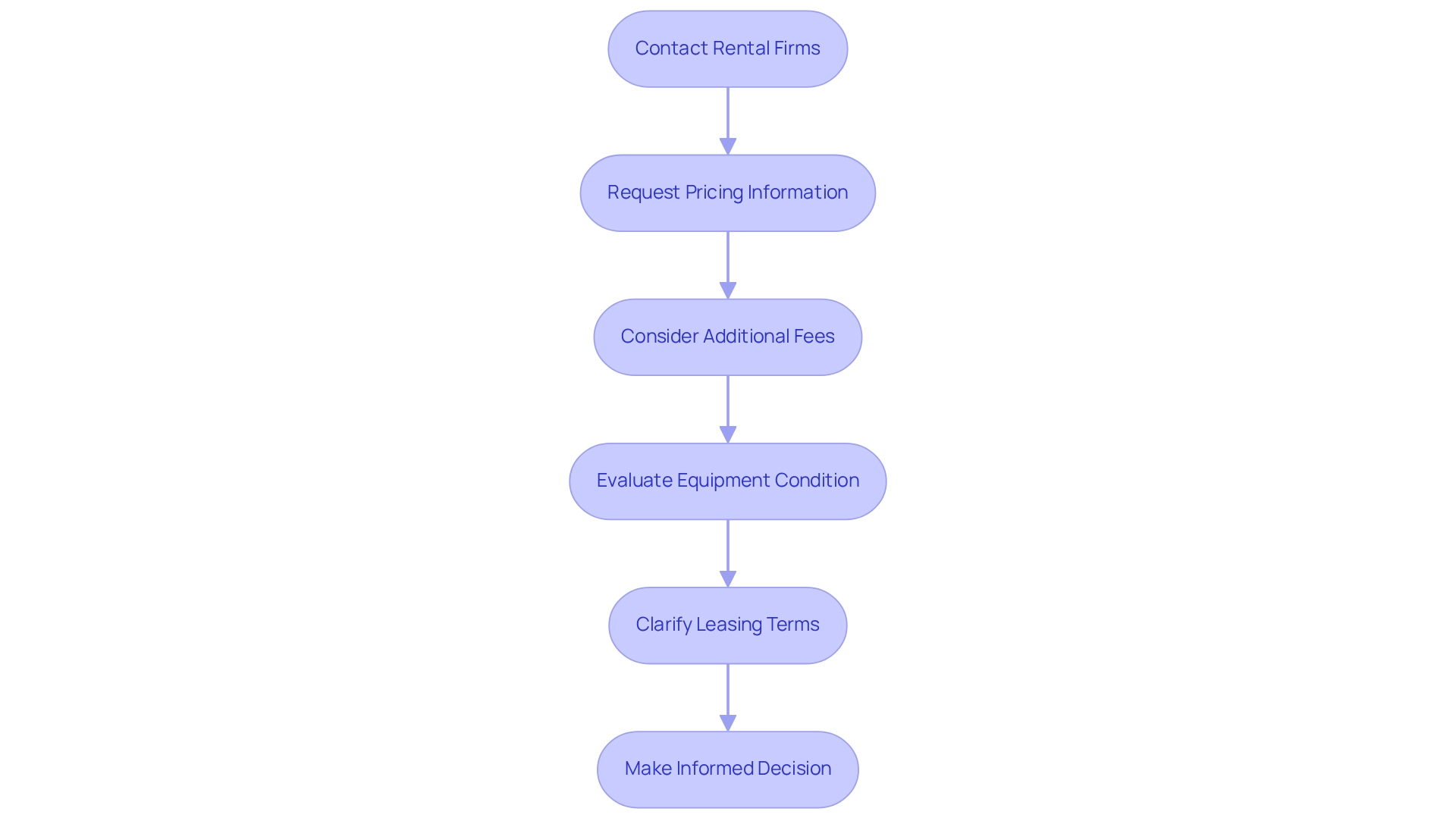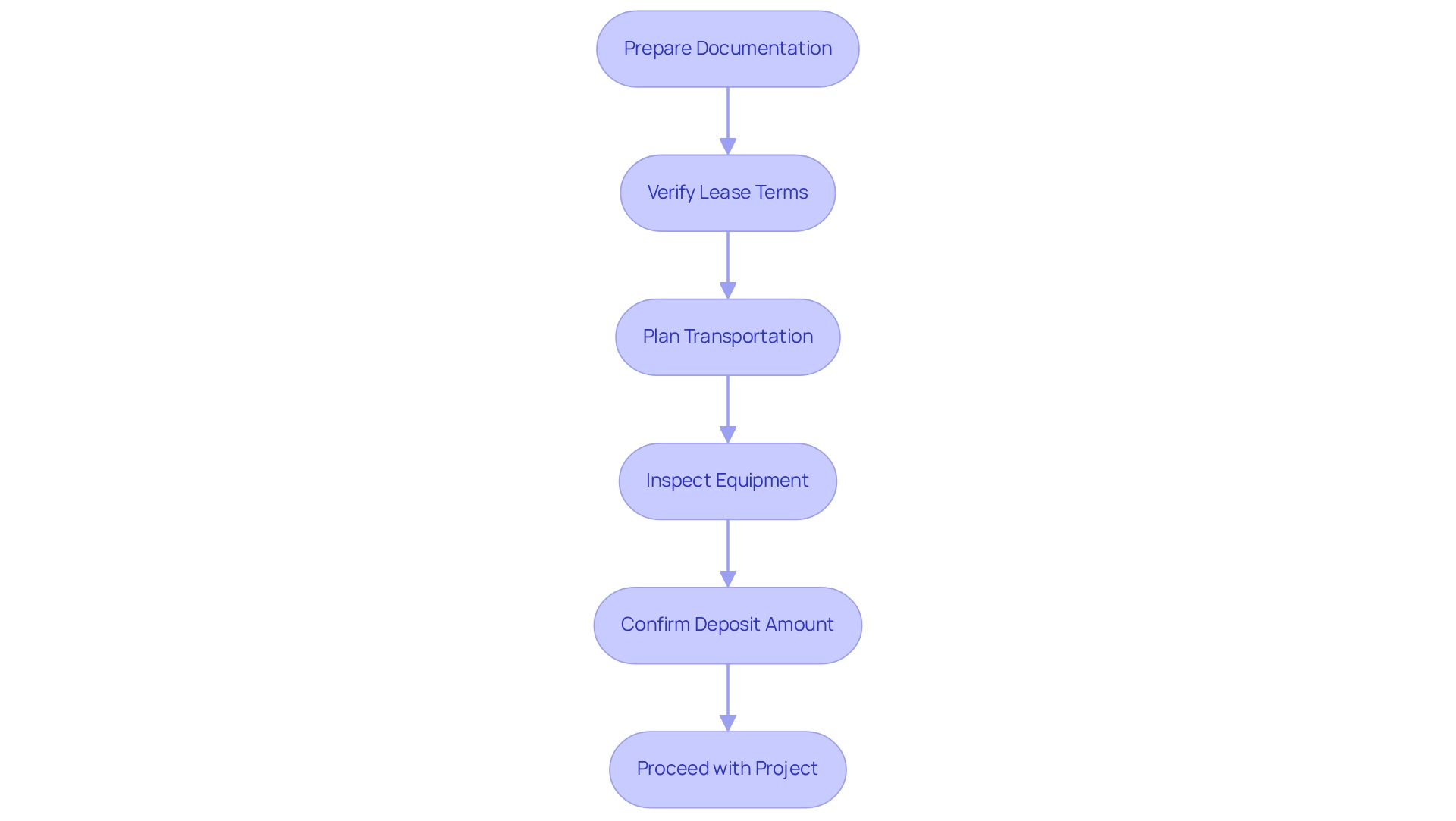Overview
To rent a tall ladder for your construction project, begin by determining your ladder requirements. Next, research local rental companies to find the best options available. Evaluate rental choices and pricing to ensure you select a service that meets your needs. Finally, prepare for the rental process by ensuring all necessary documentation is ready. This article underscores the importance of safety and thorough preparation. It details how to:
- Assess height and weight needs
- Compare rental services like EZ Tool Rental
- Streamline your rental experience effectively
Key Highlights:
- Determine the necessary height and weight capacity for the ladder or scaffold before renting.
- Safety is crucial; 140 nonfatal injuries from climbing equipment highlight the risks involved.
- Research local rental companies, focusing on customer reviews and inventory, with EZ Tool Rental being a notable option in the Dallas-Fort Worth region.
- Assess rental options by comparing pricing, terms, and additional fees like delivery and insurance.
- Prepare necessary documentation, including ID and credit card, to streamline the rental process.
- Inspect the equipment for damage before signing the lease to ensure safety and compliance.
Introduction
Navigating the world of ladder rentals can be a daunting task, particularly for individuals embarking on construction projects or home improvements. However, selecting the right ladder significantly enhances safety and efficiency. This process requires careful consideration of various factors, including determining the appropriate height and weight capacity, as well as researching reliable rental companies. Understanding the intricacies of ladder rentals is essential for a successful experience.
This article delves into the key steps involved in selecting the right ladder for your needs, evaluating rental options, and ensuring a smooth rental experience—all while prioritizing safety and compliance with industry standards. Whether you are a novice or a seasoned professional, this guide aims to streamline the ladder rental process and empower you to make informed decisions. By focusing on quality and reliability, we provide the insights necessary to navigate this essential aspect of your project.
Identify Your Ladder Requirements
Begin by determining the necessary height to reach. Measure the vertical distance from the ground to the highest point of your work area. For instance, if your goal is a ceiling at 12 feet, select a step tool that extends to at least 16 feet to ensure safe usage. Additionally, evaluate the weight capacity of the step structure. If you plan to carry tools or materials while on the step, confirm that it can support your weight along with any extra load. Notably, there were 140 nonfatal injuries reported from using climbing equipment across various occupations, underscoring the importance of safety and the potential risks involved in their usage.
Common types of stepping tools include designs for lower elevations and extension models for greater heights. As OSHA states, "The more you and your group know about safety regarding climbing equipment, the greater your chances are of preventing injuries related to it or even worse, a workplace fatality."
Compile a list of your specific requirements, including height and weight capacity, before moving to the next steps in your leasing process. Furthermore, are essential for employees to understand the hazards associated with elevated structures and safety practices, fostering a culture of safety that emphasizes adherence to OSHA standards.
Research Local Rental Companies
Begin your search for scaffold leasing options by exploring online, with a focus on those that prominently feature scaffolds in their inventory. EZ Tool Rental stands out in the Dallas-Fort Worth region due to its exceptional customer support, offering a variety of climbing options, including extension types, step types, and specialty varieties tailored to meet diverse construction needs. As the demand for equipment in both residential and industrial construction is projected to increase at a 4.5% CAGR from 2024 to 2034, identifying reliable scaffold leasing options is crucial in this growing market.
To assess the reliability and quality of service, consult customer reviews on platforms like Yelp and Google. These sites provide valuable insights into customer satisfaction scores and experiences with EZ Tool Leasing. Furthermore, visiting the EZ Tool Leasing website allows you to examine their inventory and understand their leasing policies. Look for the specific type of step tool you require, along with positive customer testimonials that highlight the company's commitment to support.
By compiling a shortlist of reputable firms, particularly focusing on EZ Tool Leasing, you can streamline your decision-making process. This ensures you select a dependable scaffolding service for your construction project, ultimately enhancing your project's success.
Evaluate Rental Options and Pricing
Begin by contacting EZ Tool Hire and other selected leasing firms to inquire about how to rent a tall ladder for the step you require. Request comprehensive pricing information, including rates for various durations—daily, weekly, or monthly—and ask about any additional fees, such as delivery charges or insurance costs. For example, you may find that offers a 26-foot step for $30 daily, while another firm charges $40. In these scenarios, consider the total value, which includes not only the cost but also the condition of the equipment and the quality of customer service provided.
When evaluating leasing options, it is essential to clarify the terms of the leasing contract. This means understanding the required deposit, the policies for late returns, and any potential charges for excessively dirty items, which could incur an extra cleaning fee of $50, as noted by EZ Rental. In the Dallas-Fort Worth region, average leasing costs for tools in 2025 reflect a competitive market, especially when you need to rent a tall ladder, as prices vary based on the type and height of the equipment. Furthermore, EZ Equipment Rental offers delivery services for rented equipment to job sites across the DFW Metroplex, adding convenience for customers. By considering these factors, including the ladder leasing capacity of 225 lbs., you can make a well-informed choice that aligns with your project requirements and budget.

Prepare for the Rental Process
Before visiting , ensure you have all necessary documentation ready. This typically includes a valid ID, a credit card for the deposit, and any required insurance information. According to a leasing company representative, 'Having your documentation in order not only accelerates the process but also guarantees you fulfill all legal requirements when you rent a tall ladder and other equipment.' It's essential to verify the lease terms and conditions, particularly the pickup and return times.
For larger structures, plan your transportation carefully; a truck or a vehicle with ample space may be necessary to accommodate the equipment safely. With leased vehicle prices up 1.4% from a year ago, it is wise to consider the costs associated with transportation. On the day of the lease, conduct a thorough inspection of the scaffold for any signs of damage before signing the lease agreement. Verify that it meets your safety standards and is in optimal working condition. Additionally, be aware that average deposit amounts for those who rent a tall ladder can vary, so it's beneficial to inquire about this beforehand. With everything checked and confirmed, you can proceed with your project with confidence.

Conclusion
Selecting the right ladder for rental is a critical step in ensuring safety and efficiency during any construction project or home improvement task. By identifying specific ladder requirements—such as the necessary height and weight capacity—users can make informed choices that prioritize safety. Understanding the various ladder types and their intended uses, along with the importance of training in ladder safety, lays the foundation for a successful rental experience.
Researching local rental companies, such as EZ Equipment Rental, is essential for finding reliable services that meet specific project needs. By examining customer reviews and exploring inventory options, renters can streamline their selection process and ensure they are choosing a reputable provider. Evaluating rental options and pricing also plays a crucial role; comparing rates and understanding the terms of the rental agreement helps to secure the best value and avoid unexpected costs.
Finally, preparing for the rental process by organizing necessary documentation and planning for transportation ensures a smooth experience. Conducting a thorough inspection of the ladder before signing the rental agreement further enhances safety and compliance. By following these key steps, individuals can navigate the ladder rental process with confidence, ultimately leading to successful project outcomes while minimizing risks associated with ladder usage.
Frequently Asked Questions
How do I determine the necessary height for my step tool?
Measure the vertical distance from the ground to the highest point of your work area. For example, if your goal is a ceiling at 12 feet, choose a step tool that extends to at least 16 feet for safe usage.
What should I consider regarding the weight capacity of a step tool?
Evaluate the weight capacity of the step structure, ensuring it can support your weight along with any tools or materials you plan to carry while on the step.
Why is safety important when using climbing equipment?
There were 140 nonfatal injuries reported from using climbing equipment across various occupations, highlighting the importance of safety and the potential risks involved.
What types of stepping tools are available?
Common types include designs for lower elevations and extension models for greater heights.
How can knowledge of safety practices impact climbing equipment usage?
According to OSHA, the more knowledge you and your group have about safety regarding climbing equipment, the greater your chances are of preventing injuries or workplace fatalities.
What steps should I take before leasing a step tool?
Compile a list of your specific requirements, including height and weight capacity, before proceeding to the next steps in your leasing process.
Why are training programs essential for employees using elevated structures?
Thorough training programs help employees understand the hazards associated with elevated structures and safety practices, fostering a culture of safety that emphasizes adherence to OSHA standards.




